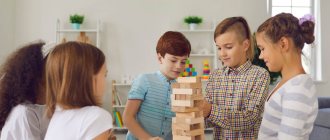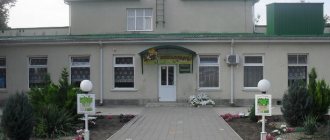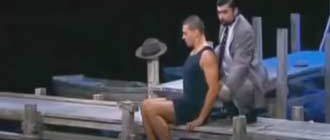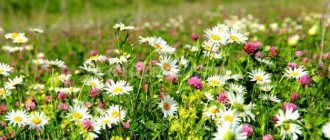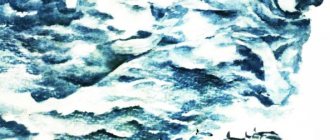MAGAZINE Preschooler.RF
Cognitive - research activities of older preschoolers, Complex lesson “Comparison of sand, clay and stones.”Objectives: to form children’s understanding of the properties of sand, clay, stones; teach how to compare materials and correctly name their features. Use them in crafts according to their properties. Introduce the hourglass, develop a “sense of time”
, creation.
Material: stones and clay (for each child)
;
dry sand in a bowl; sand spoon; hourglass (at 1 and 10 minutes)
; 1 large and two medium jars of water; 2-3 nails, hammer; modeling boards, tray for collective modeling; chips to reward children for correct answers; emblems for each child in accordance with the team name; tape recorder, cassette tape.
Progress of the lesson:
1 part.
Children stand around the teacher.
Educator. “Guys, today we are with you... (there is a knock on the door). I wonder who it could be? Everything is in place, we are not waiting for anyone else. (Dunno enters). Yes, Dunno came to us. Hello, Dunno!
Dunno (upset)
.
“Hello...”
Teacher. "What's happened? Why are you so upset? Maybe we can help you with something?”
Dunno. “Yes, this Znayka, a smart one, says that you can make something out of this garbage (he takes off his briefcase from behind his back, shows stones, clay and sand). And what can be made of all this? (scratching head)"
.
Educator. “You have come to the right place, because today the guys and I will get acquainted with the properties of sand, clay and stones. Stay with us and you will find out everything yourself.
To begin with, we will divide into two teams: “Chamomile”
and
"Bells"
.
Guys, take your seats... But what is this? We seem to have ended up in some kind of laboratory. There are different materials and tools on the table (on the table children see stones, sand, clay, jars of water, a hammer, nails, etc.)
Let's imagine that we are laboratory workers. I am a researcher, and you are my assistants (or assistants)
.
(The teacher offers to put aprons on the children, he himself puts on a white robe and glasses)
. Now we will conduct experiments.
Sit comfortably, facing the table, pay attention to the materials lying in front of you. Let's compare these materials and highlight their properties. First, we will determine the properties of sand, clay, and then stone. (A sensory examination of materials is carried out: children examine them, feel them, try to sprinkle them, press them, hammer a nail into them, throw them)
.
Sand rustles when poured onto the table, and when a piece of clay falls, a knock occurs. Sand (dry)
crumbles, but the clay does not; you can change the shape, i.e. clay is plastic. Sand consists of small grains, and clay is a homogeneous mass.
Stone and clay.
When they hit each other, the stone makes a sound, but the clay does not. The teacher tries to hammer a nail into a stone (the stone is hard, so the nail cannot be driven in)
;
the clay is soft (the nail goes in easily, without using a hammer)
. When pressed, the stone does not change shape, but the clay does.
Stone and sand.
Educator. Take a stone and a handful of sand. Touch the stone and sand, hold them in your hands. What stone? That's right, hard. And the sand is crumbly. If you throw a stone on a table, what sound does it make when it hits, it rattles correctly. And sand, when poured on the table, rustles. What is heavier, stone or sand (an experiment is carried out comparing stone and sand)
Experience: sand is poured into one jar of water, stones are placed in another; children watch how the material settles to the bottom; then two materials (stones and sand)
everything is mixed with a stick. Children observe what will settle to the bottom first. Children draw conclusions: stones are heavier than grains of sand, they settle earlier.
Children draw conclusions after comparing all materials.
Part 2.
Physical exercise: children stand up, count the chips, and determine the results of the competition. The winning team takes a lap of honor, the other team applauds (to music)
.
Part 3.
Educator. Next we will go to the pottery workshop. (Children take their seats)
.
The teacher clarifies in a conversation with them how and why people use natural materials (sand, clay and stones)
.
Stones - in the construction of houses (foundation)
, dear.
Clay – in the manufacture of bricks, pottery, handicrafts (in folk and applied arts)
, toys.
Sand - during construction (preparing a mortar that holds bricks together)
.
“A long time ago, people used hourglasses to tell time, and they looked like this (hourglass demonstration)”
.
Children observe the movement of sand for a minute. Then another hourglass is set (for 10 minutes)
; It is proposed to make any toy in 10 minutes. The teacher, Dunno and the children also make a toy from clay during this time. After 10 minutes have passed, the teacher draws the children’s attention to the time: “10 minutes is quite a lot, everyone managed to do a lot of different crafts together.
Next, the teacher suggests remembering what’s new they (the children and Dunno)
learned in class.
(Children's answers)
.
The teacher turns to Dunno: “Well, Dunno, was it interesting for you in our lesson?”
Dunno: “Yes, very much. I learned so many new and interesting things. And now let Znayka not think that he is the smartest. Well, I'm off. Thank you! Goodbye.
Children and teacher: “Goodbye”
.
Teacher: “Guys, let’s wash our hands and rest”
.
Educator: Grishanina L.M.
GBOU secondary school No. 2 SP kindergarten "Teremok"
| Next > |
Why does sand flow well?
Objectives: Identify the properties of sand and clay: flowability, friability.
Materials and equipment: Containers with sand and clay; containers for pouring; magnifying glass, screen, sieve.
Progress:
An adult invites children to fill cups with sand and clay, examine them and guess them by the sound of the substances being poured. They find out what was poured best (sand) and check it by pouring the substances from glass to glass. Then pour the sand into a large container in a slide and watch what happens (the sand remains in the form of a slide with smooth edges). In the same way, pour out the clay and determine whether the slides are the same (the clay slide is uneven). They find out why the slides are different (the sand particles are all the same, the clay particles are all different shapes and sizes). Children use a magnifying glass to examine what sand is made of and what grains of sand look like; what clay particles look like; compare them (the grains of sand are small, translucent, round, do not stick to each other; the clay particles are small, pressed very closely together). Children sift sand and clay through a sieve and find out whether particles of sand and clay pass through it equally well and why. They examine the hourglass and find out whether it is possible to make a clay clock (no, the clay particles do not flow well and stick to each other).
Let's plant a tree
Objectives: Determine the properties of sand and clay: flowability, friability.
Materials and equipment: Containers with sand, clay, sticks.
Progress:
An adult and children try to plant a tree first in a container with sand, then in a container with dry clay. They find out where the stick sticks easier (into the sand) and why (it is loose, loose). They clarify where the stick holds better and why (it holds better in clay, it is denser).
Wind
Objectives: Identify changes in sand and clay when interacting with wind and water.
Materials and equipment: Transparent containers with sand and clay, the containers are closed with a lid with an inserted plastic bottle.
Progress:
An adult invites children to find out why it is inconvenient to play with sand in strong winds. Children examine the prepared “sandbox” (a jar filled with a thin layer of sand or clay). Together with an adult, they create a hurricane - they sharply, forcefully squeeze the jar and find out what is happening and why (since the grains of sand are small, light, do not stick to each other, they cannot hold on to each other or to the ground with a strong stream of air) . Children are asked to use the results of previous experience (“Why does sand flow well?”). They determine how to make it possible to play with sand even in strong winds (wet the sand well). They are asked to repeat the experiment and draw a conclusion.
Where is the water?
Objectives: Determine that sand and clay absorb water differently.
Materials and equipment: Transparent containers with dry sand, dry clay, measuring cups with water.
Progress:
An adult invites children to find out the properties of the dog and clay by testing them by touch (loose, dry). Children pour the same amount of water into the cups at the same time (pour just enough water so that it completely sinks into the sand). They find out what happened in containers with sand and clay (all the water has gone into the sand, but stands on the surface of the clay); why (clay particles are closer to each other and do not allow water to pass through); where there are more puddles after rain (on asphalt, on clay soil, since they do not let water in; on the ground, in the sandbox there are no puddles); why paths in the garden are sprinkled with sand (to absorb water).
Magic material
Objectives: Identify what properties sand and clay acquire when wetted.
Materials and equipment: Container with sand, clay, planks, sticks, ceramics.
Progress:
An adult invites children to make balls, sausages, figures from sand and clay: let them dry, and then check the strength of the buildings. Children draw conclusions about the viscosity of wet clay and the retention of its shape after drying. They find out that dry sand does not retain its shape. They are discussing whether it is possible to make dishes from sand and clay. Children test the properties of sand and clay by making dishes from them and drying them. They guess what the dishes are made of, for which they pour water into them and check the material based on the results (“sand dishes” do not hold water and break; clay dishes retain their shape for some time).
Self-analysis of the lesson “Mineral resources. Sand, clay, granite, limestone"
Self-analysis of an open lesson,
conducted in the 3rd grade of MCOO Bolshekandalinskaya Secondary School
Subject: The world around us (UMK “Planet of Knowledge”; Textbook “The world around us”, grade 3, part 1. Authors: I.I. Ivchenkova, I.V. Potapov, 2017)
Lesson topic: “Minerals. Sand, clay, granite, limestone.”
Lesson type: Lesson on learning new material, is a logical development of the previous lesson “Rocks”.
This lesson is lesson 2 of the “Rocks and Soil” section. Lesson type: lesson on discovering new knowledge; lesson form: research lesson.
Form of organization of educational activities: individual - group, frontal.
The following tasks were set for the lesson:
1.Subject:
— form the concepts of “mineral resources”, “deposit”;
— to form students’ ideas about the composition and properties of clay, sand, granite, limestone
2. Metasubject UUD:
a) Cognitive UUD:
— develop the ability to work with collection material and conduct experiments;
- develop the ability to compare, analyze, generalize, draw conclusions, and present information in table form.
b) Regulatory UUD:
- develop the ability to concentrate;
- develop the ability to control and adjust one’s activities, and independently perform experiments.
c) Communicative UUD:
- develop the ability to work in a group, in pairs;
— to develop the ability to present the result of one’s activities and the result of the activities of a friend;
- develop the ability to express your opinion and prove your point of view.
3. Personal:
— create positive motivation for learning;
— develop children’s cognitive activity and speech;
- create a sense of respect for a friend.
The lesson was held in a class where there were mainly children with an average level of mental activity. The class is efficient, hardworking, active. When conducting a lesson, it is very important to use health-saving technologies, a comfortable, friendly environment, and create a situation of cooperation.
The content, equipment of the lesson, organization of active mental activity at all stages of the lesson, individual, paired, group and frontal forms of organizing the educational activities of schoolchildren, the use of verbal methods, research work when studying new material, creative activity contributed to the achievement of the triune goals of the lesson, stimulated the cognitive interests of students . To activate students’ thinking, she used a system of questions, created problem situations, used subject-based activities, and technology of student-centered learning.
The lesson was structured in the form of practical research work, where students themselves became familiar with the properties of minerals and made certain conclusions. The lesson was accompanied by a slide show. The organizational moment passed quickly, all the children were ready for the lesson, the tables were in order, everything they needed was there. With the help of introductory dialogue, the children formulated the topic of the lesson, set goals for the activity, and developed a joint action plan. When studying new material, the meaning of new words was found in explanatory dictionaries. When performing the experiments, pair work was used, the children asked each other questions and drew conclusions. After summing up, the data was entered into a notebook. The children independently told interesting material about the hard work of geologists and the properties of minerals. During the lesson, a special place was given to the regional component. The guys got acquainted with the map of the Ulyanovsk region, found out what minerals the region and the Staromainsky district are rich in. The next stage is the assimilation of the studied material, the application of the acquired knowledge in constructing a logical statement. In order for children to believe in themselves and realize that everyone has all the necessary knowledge to answer any question, assistance is provided in the form of additional material on the topic. Reinforcement takes place using a voting system. The children cope with the task.
At the end of the lesson, the children conclude that at each lesson they gain new knowledge and make discoveries for themselves. When independently assessing their activities in the lesson, they used a scale in the form of a mountain, where geologists study minerals. Using emoticons, each child assessed the level of their knowledge. The children each received interesting homework assignments for themselves; each one took the assignment that he liked.
The use of computer technology in the classroom provided an opportunity for children to perceive the material holistically. Rational use of every minute, a good pace of the lesson made it possible to diversify the activities of students and helped to involve all children in the work. Health-saving technologies were used in the lesson. Changing places of work, types of activities, physical training - all this prevented physical fatigue of students.
The psychological atmosphere was friendly. During reinforcement and independent work, the children were active and worked with interest. Throughout the entire lesson, there was a high level of student cognitive activity: students told stories, worked actively in pairs, answered questions, reasoned, based on life experience and knowledge gained in the lesson, and drew conclusions.
I believe that the chosen form of organizing the educational activities of schoolchildren was quite effective. On my part, the norms of pedagogical ethics and tact, the culture of communication “teacher-student”, “student-student”, reflection and self-assessment of the lesson were observed.
Date of: ____________
Primary school teacher: _______ V.I. Kiryukhina
